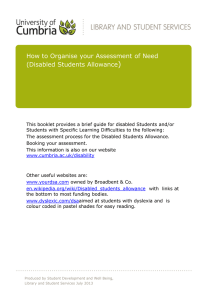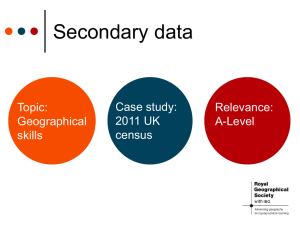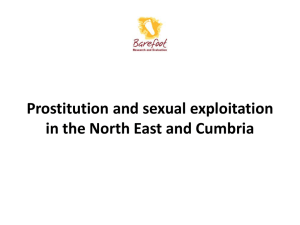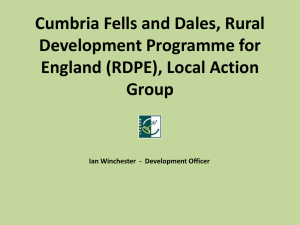Second Release - Cumbria County Council
advertisement
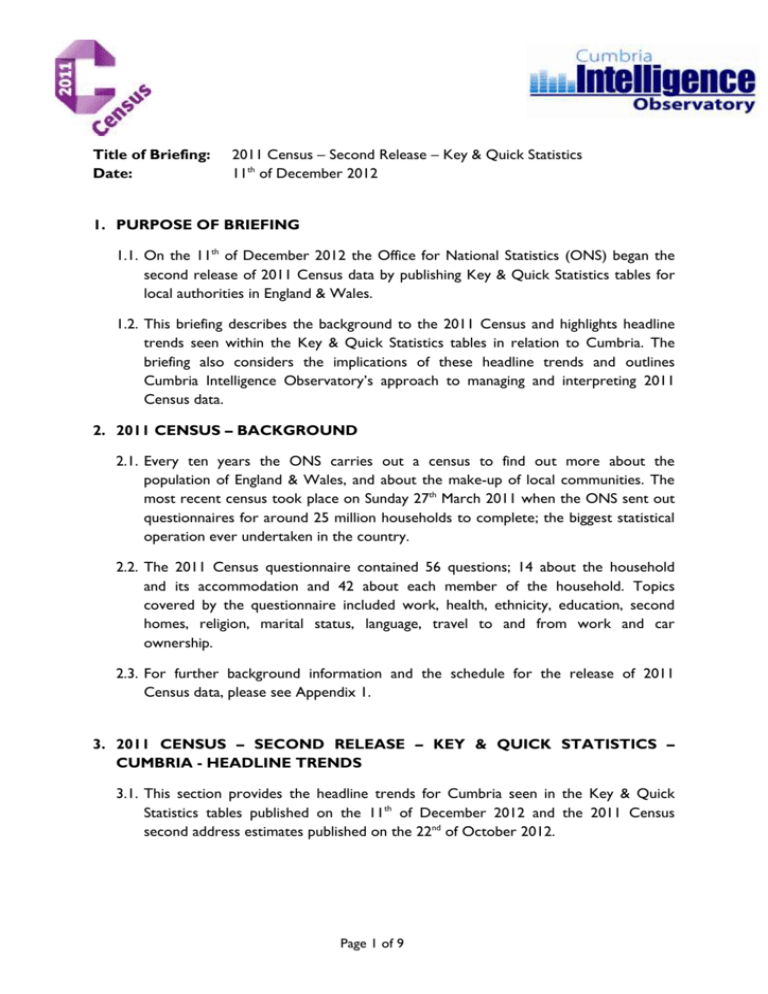
Title of Briefing: Date: 2011 Census – Second Release – Key & Quick Statistics 11th of December 2012 1. PURPOSE OF BRIEFING 1.1. On the 11th of December 2012 the Office for National Statistics (ONS) began the second release of 2011 Census data by publishing Key & Quick Statistics tables for local authorities in England & Wales. 1.2. This briefing describes the background to the 2011 Census and highlights headline trends seen within the Key & Quick Statistics tables in relation to Cumbria. The briefing also considers the implications of these headline trends and outlines Cumbria Intelligence Observatory’s approach to managing and interpreting 2011 Census data. 2. 2011 CENSUS – BACKGROUND 2.1. Every ten years the ONS carries out a census to find out more about the population of England & Wales, and about the make-up of local communities. The most recent census took place on Sunday 27th March 2011 when the ONS sent out questionnaires for around 25 million households to complete; the biggest statistical operation ever undertaken in the country. 2.2. The 2011 Census questionnaire contained 56 questions; 14 about the household and its accommodation and 42 about each member of the household. Topics covered by the questionnaire included work, health, ethnicity, education, second homes, religion, marital status, language, travel to and from work and car ownership. 2.3. For further background information and the schedule for the release of 2011 Census data, please see Appendix 1. 3. 2011 CENSUS – SECOND RELEASE – KEY & QUICK STATISTICS – CUMBRIA - HEADLINE TRENDS 3.1. This section provides the headline trends for Cumbria seen in the Key & Quick Statistics tables published on the 11th of December 2012 and the 2011 Census second address estimates published on the 22nd of October 2012. Page 1 of 9 Population Cumbria’s resident population on census day 2011 was 499,900 – an increase of 12,300 people (+2.5%) since 2001. This increase was lower than that of England & Wales (+7.8%); Cumbria has an older population profile than England & Wales - with lower proportions of residents in younger age groups and higher a proportions of residents in older age groups; 21% Cumbria’s population is aged over 65 years – higher than England & Wales (16%). Since 2001 the number of residents aged over 65 years in Cumbria has increased by 15% - a faster increase than the national average (+11%). Barrow-in-Furness had the greatest population decline of all local authorities in England & Wales (-4%); At 25 people per km², Eden had the lowest population density in the country while South Lakeland had the 12th lowest. Second Addresses 21,900 people reported they had a second address located within Cumbria – this equates to 44 persons per 1,000 usual residents of the county - much higher than the England & Wales average (28 per 1,000); South Lakeland and Eden ranked 6th and 13th highest nationally for the rate of people with a second address located in the area. Housing and Households Just over 60% of households in Cumbria are one family households, while 32% are one person households; Compared to the national average, Cumbria has a slightly higher proportion of older people living alone and the county ranks 2nd highest for the proportion of one person households with person aged under 65 years; 32% of houses in Cumbria are semi-detached, while 30% are terraced and 25% are detached, furthermore, Cumbria has the 2nd highest proportion of terraced housing of all counties; 39% of households in Cumbria are owned outright, while 32% are owned with a mortgage or loan (in 2001 these proportions were 35% and 37% respectively); The proportion of households that are owned outright is much higher within the county than the national average (England & Wales – 31%); Of all local authorities in England & Wales, Barrow ranks lowest for shared ownership households and Copeland ranks 4th lowest for households renting from Page 2 of 9 private landlord or letting agencies. Interestingly, Eden ranks 10th highest for households living rent free; 4% of households in Cumbria do not have central heating – the 2nd highest proportion of all counties. Barrow also ranks 2nd highest for the proportion of households with no central heating of all local authorities; The average household size in Cumbria is 2.2 persons per household - the joint lowest average household size of any county; There are 12,593 lone parent households in Cumbria; Cumbria has the 4th highest proportion of ‘lone parents in part-time employment’ at 40.7% (5,123); and the 4th highest proportion of ‘female lone parents in part-time employment’ at 39.3%; The district of South Lakeland has the second highest proportion of ‘lone parents in part-time employment’ households at 47.1%; followed by Eden (5th highest) at 46.7%. Both districts have the joint second highest proportion of ‘female lone parents in part-time employment’ at 45.4%; Barrow has the 5th highest proportion of ‘male lone parents not in employment’ at 4.6%. Health In Cumbria there are 6,157 (2.8%) households with ‘no adults in employment with dependent children’, this is below the national average (England & Wales) of 4.2%; Cumbria has the 2nd highest proportion (23.9%) of households with ‘one person with a long-term health problem or disability: with no dependent children;’ the district of Barrow has the 3rd highest proportion at 27.3%; 9.7% of people in Cumbria say their ‘Day-to-day activities are limited a lot’, this is above the national average of 8.5%, the 2nd joint highest county in England & Wales; the district of Barrow has the joint highest proportion at 13.0%; 4.7% of people in Cumbria say that their health is ‘bad’, the 3rd joint highest county in England & Wales; the district of Barrow has the second highest proportion of people who say their health is ‘bad’ at 6.6%; 56,495 people living in Cumbria provide unpaid care; Cumbria has the joint highest proportion of people who ‘Provides 20 to 49 hours unpaid care a week’ at 1.5% (7,265 people); and Barrow has the joint 2nd highest proportion at 1.9% (1,308); There are 1,289 communal establishments in Cumbria, containing a total of 8,919 people; 14.4% of people have residency in a care home with nursing, similar to the national average of 14.9%; and 23.2% are in a care home without nursing, slightly above the national average of 21.4%; Page 3 of 9 8.3% of care homes are Local Authority care homes, higher than the rest of England & Wales at 1.7%; 48.8% of people are resident in ‘other’ establishments, below the national average of 57.0% Economy & Transport 368,880 people reported they were economically active in Cumbria in 2011 (working, seeking work, some students) which is 69.7% of the population aged 16-74, the same rate as England & Wales; In 2011 the employment rate in Cumbria was 63.9%, slightly higher than the England & Wales average of 61.9%; Eden has the 4th highest rate of self-employment in England & Wales (17.3%); 12,346 people in Cumbria reported that they were out of work (claiming and not claiming benefit), 4.8% of the economically active population. The rate was highest in Barrow at 7.0% and Copeland at 6.3%, the average for England & Wales was 6.3%; Since 2001 there are 192 more people reporting that they are unemployed in Cumbria, giving a total of 12,346 which is a rise of 1.6%. The rise nationally was 42.6%; 243,231 people in Cumbria reported having done some paid work in the week before the Census with the highest number in wholesale/retail (39,128), closely followed by manufacturing (32,278); Eden has the 2nd highest proportion of employment in agriculture in England & Wales at 8.1% (E&W 0.9%). Barrow and Copeland have the 3rd and 5th highest respectively in manufacturing at 21.0% and 20.0%, twice the national average in both cases. South Lakeland and Eden have the 5th and 7th highest proportions of employment in accommodation and food services at 11.9% and 11.3%, also twice the national average; Skilled trade occupations account for the highest proportion of employment in Cumbria at 16.2% (E&W 11.5%). This is particularly high in Eden at 19.5%, placing it 4th highest in the country; Employment in professional occupations is lower in Cumbria than nationally at 14.0% (E&W 17.4%); Almost a third of people (31.4%) in Cumbria work part time compared to a national average of 29.1%. Females in Cumbria are more likely to work part time than the national average (50.7% v 44.2%); A quarter (24.6%) of the population aged over 16 in Cumbria is qualified to level 4 or above (degree) which is slightly below the national average of 27.2%; Page 4 of 9 Barrow has the highest proportion of adult residents with an apprenticeship qualification in England & Wales, 9.2%, and Copeland has the third highest at 5.9% (E&W 3.6%); 79% of households in Cumbria have access to cars and vans – higher than the national average (74%). Equalities Cumbria has the highest proportion of White British residents of any English county (96.5% compared to 80.5% in England & Wales); However the county has seen an increase in ethnic diversity as the proportion of White British residents in 2001 was 98.0%; Allerdale has the second highest rate of White British residents of any district (97.6%), slightly behind Redcar and Cleveland. Copeland ranks 5th (97.3%), Barrow ranks 9th (97.1%) and Eden ranks 10th (97.0%); Of the minority groups 4,557 (0.9% of Cumbria's population) come from the countries that joined the EU in the first part of the last decade, compared to 2.0% for England & Wales; This ranks Cumbria as the third-lowest county for the proportion of EU-accession migrants in the population; Within this group 2,868 residents come from Poland (0.6% of Cumbria's population) and of these 1,238 live in Carlisle (1.2% of the district's population); A further 6,102 (5.7%) of Carlisle's residents were born in Scotland; 50.8% of Cumbria's population are married, higher than the England & Wales figure of 46.6%; The figure for the county is down from 54.9% in 2001; Eden residents have the highest rate of marriage (54.4%) with Barrow exhibiting the lowest rate of 46.8%; 29.1% of Cumbria's population is single (34.6% in England & Wales), and 0.2% are part of a same-sex civil partnership (same as England & Wales); Cumbria has the highest level of Christian residents of any county and England & Wales (71.9% compared with 59.3% in England & Wales); The figure has fallen, however, since 2001 when the rate for Cumbria stood at 82.2%; Levels of Christianity in Copeland are second highest of any district (78.9%, after Knowsley with 80.9%); Cumbria ranks as the second county for residents speaking English as their main language (98.3%, compared to 91.2% in England & Wales); Page 5 of 9 Within the county Allerdale ranks as the 8th district, and Copeland the 9th (both at 98.7%). 4. 2011 CENSUS – SECOND RELEASE – KEY & QUICK STATISTICS – CUMBRIA – IMPLICATIONS 4.1. Population Implications: Census data regarding population helps the Government to calculate the size of grants allocated to each local authority and health authority. In turn, these authorities use census data to plan for, and allocate resources to, services in their area; such as transport, housing, healthcare and education. 4.1. Second Address Implications: Cumbria’s high visitor population, including those with second homes, presents challenges in respect of pressures on services and infrastructure. The county can be disadvantaged by funding mechanisms for public services which are based on resident population and don’t take into account visitors. Second home numbers also have implications for local housing markets, with affordability of housing a particular issue in communities with high numbers of second homes. Local economies and employment markets are impacted on by numbers of second homes as visitors contribute significantly to the county’s economy and employment markets. The higher rates of people with second homes in parts of Cumbria has implications for local policy in respect of Council Tax and, consequently, on the resources for local services in the county. 4.2. Housing and Household Implications: Census results help to inform future landuse planning for our communities; in terms of the level of housing required, where that new housing will need to go to serve population increases, and the types of dwellings necessary to meet local demand and need. The 2011 Census shows that Cumbria’s population is higher than previous estimates suggested. Therefore, future population projections are likely to be correspondingly greater than current projections indicate. Consequently, the overall number of new dwellings required to serve the future population may be greater. Furthermore, the types of new dwellings required will have to reflect the needs of Cumbria’s increasingly ageing population. Census information on the type, size, tenure and quality of the dwellings that people currently occupy will help determine likely future dwellings requirements in Cumbria. 4.3. Health Implications: From April 2013, the responsibility of Public Health will be transferred to Cumbria County Council; who will become the strategic lead for improving the health and well-being of the population of Cumbria, supporting people to live healthy and independent lives, and narrowing health inequalities. The 2011 census results will be used by the council to inform policy and provision of care services which are focused on promoting healthy and independent lifestyles. Census data enables the Council to identify current and future health, social care and well-being needs of communities in Cumbria and will help to inform the Page 6 of 9 development and shaping of our services in order to meet these needs and challenges. Data will help the Council to: track and respond to the changing demographics and needs of the county, in particular its ageing population and the needs associated with this including the provision of care for older people; identify general health needs and individuals / households with long term illness; identify the needs/demands of carers. The County Council will use the census results to ensure that it, and other providers of health and social care, endeavor to ensure that information and support is accessible and available to those who need it most. 4.4. Economy and Transport Implications: The census shows how many people work in different occupations and industries and how employment is structured, helping local authorities, Local Enterprise Partnerships, colleges and businesses to plan jobs and training policies and to make informed investment decisions. The dominance of sectors such as tourism and manufacturing is very evident in Cumbria and the Census indicates that Cumbria has, to some extent, been protected from the effects of the recession because of its economic structure. The challenge is to exploit these assets and build on areas which are less strong in order to create increased economic prosperity in the future through a diverse economy and increasingly highly skilled workforce. Car and van availability statistics from the 2011 Census reflect the dependence on car travel in the rural areas of the county, this information will be used by Cumbria’s Highways and Transportation team to help ensure all households within the county can access key services and employment areas. 4.5. Equalities Implications: As expected, the 2011 Census has identified a number of changes over the last decade in relation to the profile of Cumbria’s population. The increase in the numbers of people who are Non-White British is partly down to the inward migration of people from EU countries and to an increase in the Asian and Asian/British population. Cumbria County Council will be able to compare 2011 Census results with the profile of people who use council services to assess whether they are providing fair access to public services; taking steps where a group is experiencing inequalities or potential discrimination. The Council has a number of Equality objectives which include: increasing the accessibility of council buildings; improving vulnerable people's access to advice, information and advocacy; increasing Gypsy Roma and Traveller educational attendance and attainment; increasing the number of young people who work for the council; and, promoting good relations between people from different backgrounds. 4.6. Children’s Services Implications: The information provided by the 2011 Census will be useful for service planning in Cumbria’s Children's Services, highlighting changes in the number of children and young people and their geographic distribution across Cumbria. Information from the Census will also support a range of services including, for example, planning for school places, specialist support for particular sub-groups within the population, and commissioning future services. Page 7 of 9 4.7. Adults & Local Services Implications: The 2011 Census clearly shows that the elderly population growth in Cumbria is as predicted. Cumbria’s Adult & Local Services are aware of the county’s higher growth of people aged 65 and over compared to the national average and the known implications this has for potential demand for services such as people who may develop dementia. It is well known from public consultation that people like to remain in their own homes and stay independent for as long as possible. Cumbria’s Adult & Local Services are shaping services which will enable people to make positive life choices around health and social care; clearly linking to the current council plan aspiration of supporting people to live an independent and happy life. The results of the 2011 Census have also highlighted areas to be further explored, these include: people of all ages with long term health problems or disability; people living alone; and people providing unpaid care. Further analysis will identify the potential different levels of need across Cumbria. 5. 2011 CENSUS– FURTHER RELEASES AND ANALYSIS 5.1. Cumbria Intelligence Observatory’s partner organisations are working together to coordinate relevant analysis of all 2011 Census data. This analysis will be used to: Build a more detailed picture of Cumbria and its communities; Enable informed strategic planning; Inform planning and delivery of services in Cumbria including schools, health provision, transport and housing; Inform a wide range of statutory needs assessments; Support lobbying activities; Support third sector organizations in funding applications and advocacy. 5.2. Over the coming weeks and months, Cumbria Intelligence Observatory will be producing more detailed briefings presenting 2011 Census statistics for Cumbria and districts. These briefings are available to view at: http://www.cumbriaobservatory.org.uk/Census/2011census.asp. 5.3. Furthermore, Cumbria Intelligence Observatory will incorporate 2011 Census data for small areas (to be released by the ONS on the 30th of January 2013) into the Cumbria Atlas; an interactive geographical tool which enables users to view data sets at a local level in a user-friendly format combining maps, tables and charts. The Cumbria Atlas can be accessed via: http://www.cumbriaobservatory.org.uk/Atlas/CumbriaAtlas.asp 6. 2011 CENSUS – FURTHER INFORMATION 6.1. More information about the 2011 Census including all statistical releases can be found at the Office for National Statistics 2011 Census homepage: Page 8 of 9 http://www.ons.gov.uk/ons/guide-method/census/2011/index.html 6.2. The 2011 Census Prospectus which outlines the timetable for future data releases can be viewed at: http://www.ons.gov.uk/ons/guide-method/census/2011/census-data/2011-censusprospectus/index.html 6.3. If you wish to discuss anything relating to the 2011 Census please contact the Cumbria Intelligence Observatory by emailing info@cumbriaobservatory.org.uk or on (01228) 226309. Page 9 of 9

